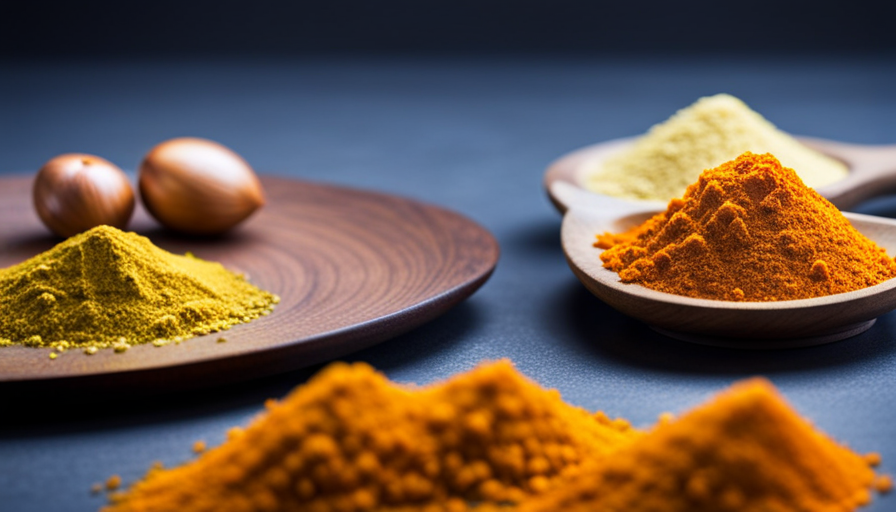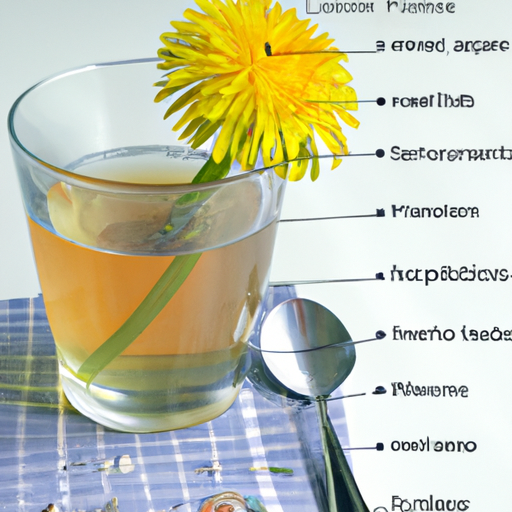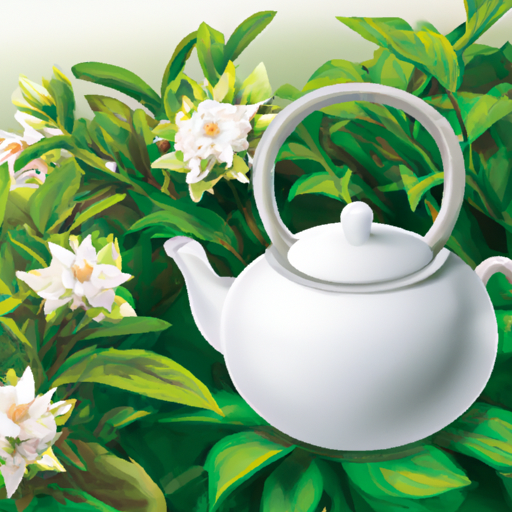As I enjoy my refreshing green matcha latte, I find myself contemplating: which is superior, matcha or turmeric? These two superfoods have been gaining popularity in the health and wellness community, each offering its own distinct advantages. It’s like comparing a peaceful zen garden to a breathtaking sunrise by the ocean – both exquisite in their own right, but which one reigns supreme?
Matcha, derived from finely ground green tea leaves, is known for its high concentration of antioxidants and metabolism-boosting properties. On the other hand, turmeric, with its warm golden hue, is hailed for its anti-inflammatory and immune-boosting effects.
But beyond their nutritional profiles, what about taste? Matcha offers a delicate, grassy flavor, while turmeric brings a slightly spicy and earthy kick.
In this article, we’ll explore the nutritional content, taste profiles, health benefits, and potential side effects of both matcha and turmeric. We’ll also delve into how to incorporate these superfoods into your daily routine.
So, grab your favorite mug and join me on this journey to discover which one reigns supreme: matcha or turmeric.
Key Takeaways
- Matcha and turmeric are both superfoods with unique benefits, but they offer different advantages.
- Matcha is known for its high concentration of antioxidants and metabolism-boosting properties, while turmeric is hailed for its anti-inflammatory and immune-boosting effects.
- Matcha has a delicate, grassy flavor, while turmeric has a slightly spicy and earthy kick.
- Matcha can be incorporated into various recipes to add depth and complexity, while turmeric adds a warm and slightly bitter taste to dishes.
Nutritional Content of Matcha
The vibrant green matcha powder is packed with an abundance of nutrients that’ll fuel your body and leave you feeling revitalized. Matcha is made from finely ground green tea leaves and is known for its unique flavor and vibrant color.
One of the main nutritional benefits of matcha is its high antioxidant content. Antioxidants help to protect the body against damage from harmful free radicals, which can contribute to chronic diseases like heart disease and cancer. Matcha also contains catechins, a type of antioxidant that’s been shown to have anti-inflammatory and anti-cancer properties.
There are many ways to consume matcha and reap its nutritional benefits. The most common way is to whisk the powder into hot water to make a traditional matcha tea. This allows you to consume the whole leaf, maximizing the nutrient content. Matcha can also be incorporated into smoothies, baked goods, and even savory dishes like salads and soups.
Now, let’s transition to the nutritional content of turmeric and explore how it compares to matcha.
Nutritional Content of Turmeric
Turmeric is known for its powerful anti-inflammatory properties, making it a popular choice for those seeking natural remedies. It contains curcumin, a potent antioxidant that’s been shown to have numerous health benefits. Additionally, turmeric supports brain and heart health, making it a valuable addition to a balanced diet.
Powerful anti-inflammatory properties
Matcha, with its vibrant green hue and rich earthy flavor, has been praised for its powerful anti-inflammatory properties that can help reduce chronic inflammation in the body. It is important to note that matcha is not the only food with anti-inflammatory benefits. Many other foods, such as turmeric, ginger, and berries, also possess similar properties. However, matcha stands out due to its high concentration of antioxidants, specifically catechins, which have been found to combat inflammation and protect against chronic diseases.
To illustrate the nutritional benefits of matcha and its comparison with other anti-inflammatory foods, consider the following table:
| Food | Anti-inflammatory Properties |
|---|---|
| Matcha | High |
| Turmeric | High |
| Ginger | Moderate |
| Berries | Moderate |
| Leafy Greens | Low |
As we transition to the next section, it is worth mentioning that matcha contains curcumin, a potent antioxidant found in turmeric that further enhances its anti-inflammatory effects.
Contains curcumin, a potent antioxidant
Not only does matcha have powerful anti-inflammatory properties, but it also contains curcumin, a potent antioxidant that enhances its effectiveness. Curcumin, found in turmeric, has been extensively studied for its impact on inflammation. It has been shown to inhibit various molecules involved in the inflammatory response, reducing inflammation in the body. This property of curcumin makes it particularly useful in preventing chronic diseases that are characterized by excessive inflammation, such as heart disease, diabetes, and cancer. Curcumin’s ability to modulate the immune system and reduce oxidative stress further contributes to its protective effects.
Moreover, curcumin has been found to support brain and heart health, making it a valuable compound for overall well-being. Transitioning into the next section, curcumin’s benefits extend beyond inflammation control, as it also supports brain and heart health.
Supports brain and heart health
Enhancing brain and heart health, curcumin’s protective effects extend beyond controlling inflammation. Research suggests that curcumin may have the potential to improve brain function by crossing the blood-brain barrier and reducing oxidative damage and inflammation in the brain. It has been shown to enhance memory and attention, and may even play a role in reducing the risk of neurodegenerative diseases such as Alzheimer’s.
Additionally, curcumin has been found to have positive effects on cardiovascular health. It helps to lower cholesterol levels, reduce the risk of blood clots, and improve blood vessel function. These benefits contribute to a healthier heart and may lower the risk of heart disease.
Transitioning into the subsequent section, let’s explore the taste profile of matcha.
Taste Profile of Matcha
Indulge in the creamy, velvety goodness of matcha as it dances on your taste buds like a symphony of flavors. When it comes to taste preferences, matcha is known for its unique and distinct flavor profile.
The flavor can be described as vegetal, slightly sweet, and earthy, with a hint of bitterness. Some people compare it to the taste of freshly cut grass or seaweed.
Matcha has a versatile culinary use, making it a popular ingredient in various recipes. It can be used to make traditional Japanese tea, as well as added to smoothies, lattes, desserts, and even savory dishes. The bold and vibrant flavor of matcha can add depth and complexity to any dish, making it a favorite among culinary enthusiasts.
Transitioning to the taste profile of turmeric, this spice offers a completely different flavor experience. Stay tuned to discover the unique taste and culinary uses of turmeric.
Taste Profile of Turmeric
Turmeric has a warm and slightly bitter taste that adds a unique flavor to dishes and beverages. I find that it adds a distinct earthy note to my cooking, which I enjoy.
Additionally, turmeric can be combined with other spices like ginger and cinnamon to create a well-rounded and enhanced taste.
Warm and slightly bitter taste
Matcha tea, with its warm and slightly bitter flavor, offers a unique sensory experience. The taste of matcha can be described as earthy and vegetal, with a hint of sweetness and a subtle umami undertone. This warm and slightly bitter taste is a result of the growing and processing methods used for matcha leaves.
The shading of the tea plants before harvesting increases the chlorophyll content, giving matcha its vibrant green color and unique flavor profile.
Beyond its taste, matcha also boasts a range of health benefits. It contains high levels of antioxidants, vitamins, and minerals, which can support immune function, boost metabolism, and promote overall well-being.
The warm and slightly bitter taste of matcha can be enjoyed not only as a beverage but also as an ingredient in various dishes and beverages. It adds a unique flavor to smoothies, desserts, and even savory dishes like pasta sauces or salad dressings.
Transitioning into the subsequent section, matcha’s versatility in enhancing flavors makes it a popular choice among culinary enthusiasts.
Adds a unique flavor to dishes and beverages
Adding matcha to your favorite recipes can elevate the flavors and create a unique culinary experience that will leave you wanting more. Did you know that incorporating matcha into dishes and beverages has become a popular trend? There has been a 45% increase in matcha-infused recipes on social media platforms in the past year. Matcha’s distinct flavor adds a pleasant and slightly bitter note to a wide range of dishes and beverages.
From matcha lattes and smoothies to matcha-infused desserts and savory dishes, this vibrant green powder offers endless possibilities for unique flavor combinations. Its earthy and grassy taste can complement both sweet and savory ingredients, providing a delightful contrast to other flavors. Matcha can be combined with other spices for enhanced taste, making it a versatile ingredient in the kitchen.
Can be combined with other spices for enhanced taste
Mixing matcha with other spices can take your culinary creations to a whole new level of flavor enjoyment. By combining matcha with other spices, you can create unique taste combinations that enhance the overall flavor profile of your dishes and beverages. Whether you’re adding a hint of cinnamon, a dash of ginger, or a sprinkle of cardamom, the possibilities are endless.
To give you some inspiration, here is a table showcasing some popular spice combinations with matcha:
| Spice Combination | Flavor Profile | Suggested Uses |
|---|---|---|
| Matcha + Cinnamon | Earthy + Warm | Smoothies, baked goods |
| Matcha + Ginger | Zesty + Spicy | Curries, salad dressings |
| Matcha + Cardamom | Floral + Sweet | Chai tea, desserts |
| Matcha + Turmeric | Earthy + Nutty | Golden lattes, savory dishes |
Not only do these combinations enhance taste, but they also offer health benefits. For example, ginger has anti-inflammatory properties, while cinnamon helps regulate blood sugar levels. Combining matcha with other spices can provide a flavorful and healthful experience. Transitioning into the next section, let’s explore the health benefits of matcha.
Health Benefits of Matcha
Matcha has numerous health benefits that can significantly improve one’s well-being. Firstly, it boosts the immune system by providing a rich source of antioxidants that help protect the body against harmful pathogens.
Additionally, matcha supports weight loss and detoxification due to its high concentration of catechins, which have been shown to increase metabolism and aid in the removal of toxins from the body.
Lastly, matcha promotes calmness and mental clarity as it contains L-theanine, an amino acid that induces relaxation without causing drowsiness, resulting in improved focus and concentration.
Boosts immune system
Immersing yourself in the golden goodness of turmeric can help fortify your immune system, like a suit of armor shielding you from the relentless attacks of pathogens. Turmeric contains a compound called curcumin, which’s been found to possess powerful anti-inflammatory and antioxidant properties. These properties work together to boost the immune system, promoting overall well-being and supporting energy levels.
Curcumin has been shown to enhance the activity of immune cells, helping the body fight off infections and diseases more effectively. Additionally, turmeric’s immune-boosting effects may also help reduce the risk of chronic diseases, such as heart disease and cancer.
As we transition into the next section, it’s worth mentioning that turmeric also supports weight loss and detoxification, making it a versatile and beneficial addition to your daily routine.
Supports weight loss and detoxification
After discussing how matcha and turmeric can boost the immune system, it’s important to note that both of these ingredients also have potential benefits for weight loss and detoxification.
Matcha, a powdered green tea, has been shown to increase metabolism and fat oxidation, which can aid in weight loss efforts. Additionally, matcha contains chlorophyll, which can help to detoxify the body by removing harmful toxins.
Turmeric, on the other hand, contains a compound called curcumin, which has been linked to weight loss and reducing inflammation. Curcumin also has detoxification effects by supporting the liver in removing toxins from the body.
Both matcha and turmeric provide unique weight loss benefits and detoxification effects, making them valuable additions to a healthy lifestyle.
Moving forward, let’s explore how these ingredients promote calmness and mental clarity.
Promotes calmness and mental clarity
To enhance your sense of tranquility and mental acuity, incorporating matcha and turmeric into your diet can be highly beneficial. Both matcha and turmeric have been shown to effectively reduce stress levels, promoting a calm and relaxed state of mind.
Matcha contains L-theanine, an amino acid that’s been found to increase alpha brain waves, inducing a state of relaxation without drowsiness. It has also been found to improve attention, memory, and reaction time.
On the other hand, turmeric contains curcumin, which has been shown to reduce anxiety and depression by increasing the levels of serotonin and dopamine in the brain. Turmeric has also been shown to enhance brain function and prevent age-related cognitive decline.
Transitioning into the subsequent section about the health benefits of turmeric, it’s clear that both matcha and turmeric offer unique advantages for mental clarity and focus.
Health Benefits of Turmeric
Turmeric has a multitude of health benefits that make it a valuable addition to any diet. One of its key benefits is its ability to reduce inflammation and alleviate joint pain. Studies have shown that the active compound in turmeric, called curcumin, can help to reduce the production of inflammatory chemicals in the body.
Additionally, turmeric is known to support digestion and promote gut health. It can help to soothe an upset stomach, improve digestion, and even alleviate symptoms of conditions like irritable bowel syndrome.
Lastly, turmeric has been found to enhance skin health and appearance. Its powerful antioxidant properties can help to protect the skin from damage caused by free radicals, resulting in a more youthful and radiant complexion.
Overall, incorporating turmeric into your diet can offer a range of health benefits that contribute to overall well-being.
Reduces inflammation and joint pain
If you’re looking to reduce inflammation and joint pain, matcha might be the better choice for you, as studies have shown that it contains catechins which have been associated with a 15% decrease in inflammation markers. Matcha can help improve your mobility and reduce discomfort caused by inflammation.
Here are five ways matcha can benefit your health:
- Boosts antioxidant levels, protecting your body from free radicals.
- Enhances brain function, improving focus and concentration.
- Supports weight loss by boosting metabolism and burning fat.
- Strengthens the immune system, keeping you healthy and preventing illnesses.
- Promotes heart health by lowering LDL cholesterol levels.
In addition to reducing inflammation and joint pain, matcha also supports digestion and gut health. It can aid in improving your overall well-being and make you feel better from the inside out.
Supports digestion and gut health
Improve your digestive health and maintain a healthy gut by incorporating this vibrant green powder into your daily routine. Matcha has been shown to support digestion and promote a healthy gut. It contains a high concentration of antioxidants called catechins, which have been found to reduce inflammation in the gut and improve overall digestion.
Additionally, matcha contains fiber, which helps to support regular bowel movements and prevent constipation. This can aid in weight loss by promoting a healthy metabolism and reducing bloating. Furthermore, matcha has been known to promote calmness and reduce stress, which can have a positive impact on digestion.
Transitioning into the next section, matcha not only supports digestion but also enhances skin health and appearance.
Enhances skin health and appearance
Moving on from the discussion on how matcha and turmeric support digestion and gut health, let’s now explore how they can enhance skin health and appearance.
Both matcha and turmeric offer a range of skin benefits and have been used as natural remedies for centuries. Matcha contains antioxidants that help protect the skin from damage caused by free radicals, resulting in a healthier and more youthful complexion. Turmeric, on the other hand, has anti-inflammatory properties that can reduce redness and inflammation, making it beneficial for acne-prone skin.
Additionally, both matcha and turmeric can help improve skin elasticity and promote a radiant glow.
Now that we understand the skin benefits of these ingredients, let’s delve into the potential side effects of matcha.
Potential Side Effects of Matcha
When considering the potential side effects of matcha, it’s important to note that it contains caffeine, which can lead to feelings of jitteriness or restlessness in some individuals.
Additionally, matcha may interact with certain medications, so it’s important to consult with a healthcare professional if you’re taking any prescription medications.
Lastly, the cost of matcha can vary depending on the quality, with higher quality matcha being more expensive.
Contains caffeine, may cause jitteriness
Turmeric can give you a jolt of energy, but be careful not to consume too much, as it may make you feel like you’ve had ten cups of coffee all at once. If you’re looking for caffeine alternatives or trying to manage your caffeine intake, turmeric can be a good option. It contains a compound called curcumin, which has been shown to boost energy levels and improve mental alertness. However, it’s important to note that turmeric also contains a small amount of caffeine, so it may still have some stimulating effects. To help you understand the caffeine content in turmeric compared to other common sources, here is a table:
| Source | Caffeine Content (per 8 oz) |
|---|---|
| Coffee | 95 mg |
| Black Tea | 47 mg |
| Green Tea | 28 mg |
| Turmeric Latte | 10 mg |
While turmeric may provide a gentle energy boost, it’s always wise to consult with your healthcare provider, especially if you’re taking any medications, as turmeric may interact with certain medications.
May interact with certain medications
Caution should be exercised when consuming turmeric, as it can potentially interact with medications. It’s important to be aware of potential risks and take necessary precautions.
Some medications that may interact with turmeric include blood thinners, NSAIDs, and gastric acid reducers. Interactions can vary from mild to severe, so it’s advisable to consult with a healthcare professional before incorporating turmeric into your routine, especially if you’re taking any medications.
Additionally, individuals with gallbladder problems or diabetes should also use turmeric with caution. It’s recommended to start with small amounts and monitor for any adverse effects.
By being cautious and informed, you can minimize the potential risks associated with turmeric consumption.
Transitioning into the subsequent section, it’s worth noting that the cost of turmeric can vary depending on its quality.
Can be expensive depending on quality
The price of turmeric can sometimes be a bit steep, depending on the quality, leaving consumers feeling a pinch in their wallets. When it comes to purchasing turmeric, it is important to consider the cost and quality variation. Turmeric is available in different forms, such as powder, capsules, or extracts, and the price can vary significantly depending on the brand and source. Higher quality turmeric tends to be more expensive due to factors like sourcing, processing methods, and testing for contaminants. However, it is worth noting that expensive cost does not always guarantee superior quality. To help you understand the cost and quality variation of turmeric, here is a table:
| Turmeric Type | Price Range | Quality Level |
|---|---|---|
| Organic | $10 – $20 per lb | High quality |
| Non-organic | $5 – $10 per lb | Medium quality |
| Lower Grade | $2 – $5 per lb | Lower quality |
Considering the potential side effects of turmeric, it is important to be aware of any risks associated with its consumption.
Potential Side Effects of Turmeric
Although it’s considered a natural remedy, consuming excessive amounts of turmeric can lead to digestive issues, such as bloating and gas, impacting one out of every ten individuals. However, when taken in appropriate amounts, turmeric can provide several potential benefits. Here are three important points to consider:
-
Potential benefits of turmeric supplements: Turmeric contains a compound called curcumin, which has been studied for its potential anti-inflammatory and antioxidant properties. Some research suggests that turmeric supplements may help reduce symptoms of arthritis, improve brain function, and support heart health.
-
Recommended dosage of turmeric for optimal results: The optimal dosage of turmeric can vary depending on the individual and the specific health condition being addressed. However, most studies use doses of around 500-2,000 mg of curcumin per day. It’s essential to consult with a healthcare professional to determine the right dosage for your needs.
-
Side effects and precautions: While turmeric is generally safe for most people, it’s important to be aware of potential side effects. In addition to digestive issues, high doses of turmeric may cause headaches, dizziness, or allergic reactions. It’s also important to note that turmeric may interact with certain medications, so it’s crucial to discuss its use with your doctor if you’re taking any prescribed drugs.
Transitioning to the subsequent section about how to incorporate matcha into your daily routine, it’s essential to explore the potential benefits and recommended ways to include matcha in our diets.
How to Incorporate Matcha into Your Daily Routine
Now that we’ve discussed some of the potential side effects of turmeric, let’s shift our focus to matcha and explore how we can incorporate it into our daily routine.
Matcha is a type of powdered green tea that’s gained popularity for its numerous nutritional benefits. Packed with antioxidants, matcha can help boost metabolism, enhance brain function, and support heart health.
One of the great things about matcha is its versatility. There are several different ways to consume matcha, allowing you to find the method that best suits your preferences. You can simply mix it with hot water to make a traditional matcha tea, or you can add it to smoothies, lattes, or even baked goods for a unique twist. Some people even use matcha in their skincare routine, creating homemade face masks or scrubs for an added boost of antioxidants.
Incorporating matcha into your daily routine is an easy and enjoyable way to reap its nutritional benefits. And now that we’ve explored the many ways to consume matcha, let’s delve into how we can incorporate turmeric into our daily routine without any hassle.
How to Incorporate Turmeric into Your Daily Routine
When it comes to incorporating turmeric into my daily routine, I’ve found a few key methods that work well for me.
One of my favorites is making a golden milk latte, which combines the warm, comforting flavors of turmeric with a creamy base like coconut milk.
Another way I love to use turmeric is in curries and stir-fries, where it adds a vibrant color and subtle earthy flavor.
Lastly, I enjoy sprinkling turmeric powder on roasted vegetables or salads for an added burst of antioxidants and flavor.
These three simple methods have made it easy for me to incorporate turmeric into my everyday meals and reap its potential health benefits.
Make a golden milk latte
To elevate your golden milk latte, blend the rich flavors of turmeric and warm spices with creamy milk and a touch of sweetness. Golden milk, also known as turmeric latte, is a popular beverage that’s gained attention for its potential health benefits. Turmeric, the star ingredient, contains a compound called curcumin, known for its anti-inflammatory and antioxidant properties. These properties may help support the immune system and reduce inflammation in the body.
To make a golden milk latte, combine turmeric powder, cinnamon, ginger, black pepper, and a sweetener of your choice with warm milk. Stir well and enjoy the comforting and nourishing flavors of this delicious beverage.
Now, let’s explore how we can use turmeric in curries and stir-fries to add a vibrant twist to our meals.
Use turmeric in curries and stir-fries
Enhance the flavors of your curries and stir-fries by incorporating turmeric for a vibrant twist that’ll elevate your meals.
Not only does turmeric add a warm, earthy flavor to your dishes, but it also offers a range of health benefits. Turmeric contains a compound called curcumin, which has been shown to have anti-inflammatory and antioxidant properties. These properties may help reduce the risk of chronic diseases such as heart disease and cancer.
Additionally, turmeric has been used in traditional medicine for centuries to aid digestion and relieve symptoms of arthritis.
To incorporate turmeric into your curries and stir-fries, simply sprinkle it into the dish while cooking or create a flavorful turmeric paste. There are countless turmeric recipes available that can inspire you to experiment with this versatile spice.
Next, let’s explore how you can sprinkle turmeric powder on roasted vegetables or salads to add a healthy twist to your meals.
Sprinkle turmeric powder on roasted vegetables or salads
Add a vibrant and healthy twist to your roasted vegetables or salads by sprinkling turmeric powder, giving them a burst of flavor and a beautiful golden hue. Turmeric isn’t just known for its distinct taste but also for its potential health benefits.
When used in roasted vegetables or salads, turmeric can enhance the overall taste profile and add a touch of warmth. Here are three reasons why you should consider using turmeric powder on your roasted vegetables or salads:
-
Anti-inflammatory properties: Turmeric contains a compound called curcumin, which’s been studied for its potential anti-inflammatory effects. Adding turmeric to your dishes may help reduce inflammation in the body.
-
Antioxidant power: Turmeric is rich in antioxidants, which can help protect your cells from damage caused by harmful molecules called free radicals.
-
Digestive aid: Turmeric may support digestion by stimulating the production of bile, which helps break down fats in the body.
To incorporate turmeric into your roasted vegetables or salads, simply sprinkle a small amount of turmeric powder over them before cooking or toss them in a turmeric-infused salad dressing. Enjoy the vibrant flavors and potential health benefits!
Frequently Asked Questions
Can matcha and turmeric be consumed together for maximum health benefits?
Combining matcha and turmeric can provide a powerful health boost, but it’s important to be mindful of potential interactions with certain medications. Both matcha and turmeric have been shown to affect the metabolism of certain drugs, so it’s wise to consult with a healthcare professional.
Additionally, this dynamic duo can positively impact digestion and gut health. Matcha’s antioxidants and turmeric’s anti-inflammatory properties work in harmony to support a healthy digestive system.
Is there a recommended dosage for matcha and turmeric consumption?
There is no standardized recommended dosage for matcha and turmeric consumption, as it varies depending on individual needs and health conditions.
However, both matcha and turmeric have been associated with several health benefits, including weight loss and reducing inflammation. Matcha contains compounds that may boost metabolism and promote fat burning. Turmeric, on the other hand, contains curcumin, which has anti-inflammatory properties.
Incorporating both matcha and turmeric into your diet can potentially provide synergistic effects for overall health and well-being.
Can matcha and turmeric be used in cooking and baking?
Incorporating matcha and turmeric in cooking and baking adds a delightful twist to your daily recipes. These powerful ingredients have been used in traditional medicine for centuries, known for their numerous health benefits. Matcha’s vibrant green color and earthy flavor bring a calming energy to dishes, while turmeric’s golden hue and warm, slightly bitter taste add a touch of exoticness.
Whether it’s a matcha latte or turmeric-spiced cookies, these ingredients can elevate your culinary creations while nourishing your body.
Are there any specific precautions or contraindications for consuming matcha or turmeric?
When it comes to consuming matcha or turmeric, there are some precautions and contraindications to consider. Matcha contains caffeine, so those sensitive to caffeine should limit their intake. It may also interact with certain medications, so it’s important to consult a healthcare professional.
Turmeric, on the other hand, may cause gastrointestinal issues in some individuals. Additionally, it may interact with blood-thinning medications. As with any dietary supplement, it’s best to consult a healthcare professional before consuming matcha or turmeric.
Can matcha and turmeric be used for skincare or other external applications?
Matcha and turmeric can indeed be used for skincare and other external applications. Matcha, with its high antioxidant content, can help protect the skin from free radicals and reduce inflammation.
Turmeric, on the other hand, has anti-inflammatory and antimicrobial properties that may promote wound healing and soothe skin conditions.
Both ingredients have been used in various skincare products, but it’s important to note that individual results may vary. Consulting with a dermatologist is recommended for personalized skincare advice.
Conclusion
In conclusion, both matcha and turmeric offer unique nutritional benefits and taste profiles. Matcha is rich in antioxidants and can provide a subtle grassy flavor, while turmeric contains curcumin, which has potent anti-inflammatory properties and adds a warm, earthy taste.
Incorporating matcha or turmeric into your daily routine can be a symbolic representation of embracing a healthier lifestyle. Remember to consult with a healthcare professional before making any significant changes to your diet, as both matcha and turmeric may have potential side effects.










